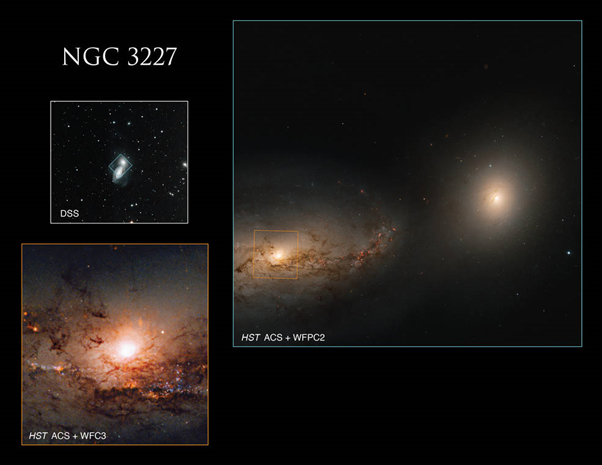

27th May 2022 (6 Topics)
Context
Hubble telescope captured a "dancing duo" of galaxies interlocked in a "gravitation dance." The two galaxies are officially known as NGC 3227, a spiral galaxy, and NGC 3226, an elliptical galaxy.
About
Key Findings:
- In a significant development, NASA has discovered a huge spiral galaxy that has been named NGC 3227.
- According to NASA, this galaxy is wrapped in a “gravitational dance”, along with NGC 3226, believed to be an elliptical galaxy.
- The two galaxies have been collectively called Arp 94.
- Both galaxies are nearly 50 and 60 million light-years from Earth and are located in the constellation Leo.
- The pair of galaxies is linked with faint tidal streams of gas and dust in its dance.
- The space agency has further discovered that NGC 3227 is the Seyfert Galaxy.
- This type of galaxy consists of a supermassive black hole at the centre and is an accrete metal which releases large amounts of radiation.
- It is estimated that about 10 per cent of all galaxies may be Seyfert galaxies.
Why is Hubble observing these galaxies?
- Hubble was looking at NGF 3227 and 3226 as part of a program to measure black hole masses by observing the dynamics of gas at the centers of bright galaxy clusters.
- At the time, Hubble was observing the two galaxies to measure black hole masses.
- Hubble assessed the dynamics of gas at the centre of bright galaxy clusters.
- Currently, scientists are attempting to understand why galaxies in the universe are either star-forming powerhouses or devoid of any star-forming activity.
- Young galaxies that form stars are usually spiral shaped, like our own Milky Way.
- Elliptical galaxies are older galaxies with no star-making capabilities.
- The NGC 3226 is currently in a transition stage, stuck in the middle of this life-cycle.
- Scientists want to understand how a life-giving galaxy slips into a lifeless lull over time.

- Scientists want to understand how a life-giving galaxy slips into a lifeless lull over time.
|
Hubble Space Telescope
|

